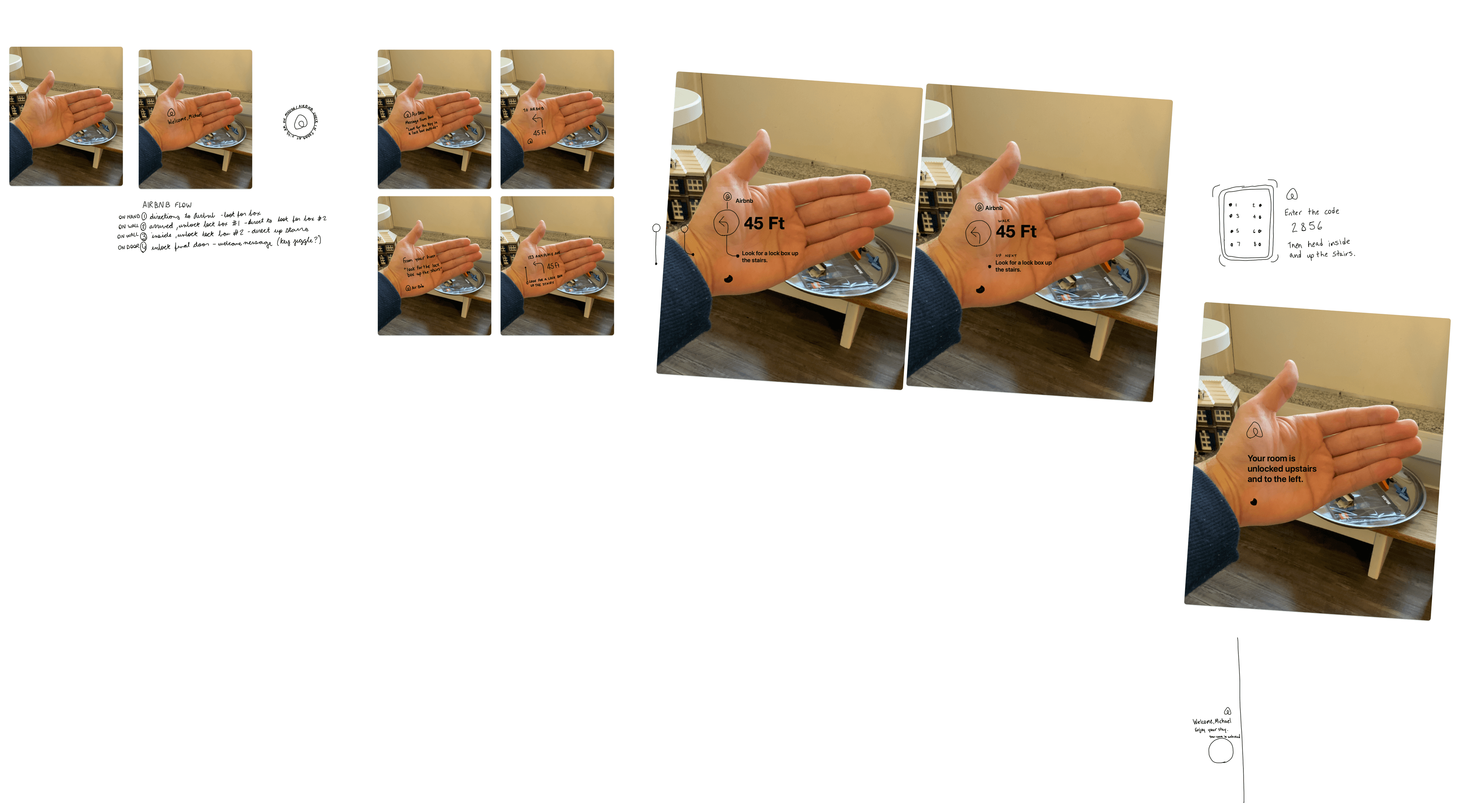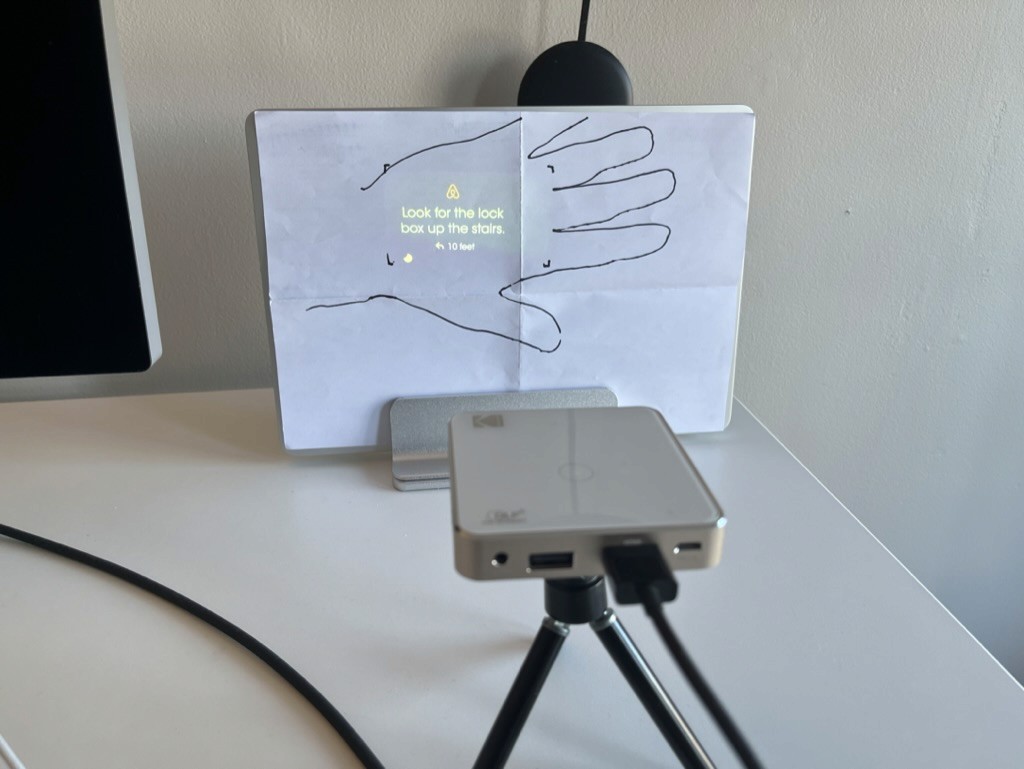3/20/23
Checking in to an Airbnb
How AI-powered hardware might help you check in to an Airbnb by providing directions to the location, the necessary information to enter the property, and a personalized welcome message.
Background
This is the first Humane concept I worked on, inspired by a recent trip to San Francisco where I checked in to an Airbnb. I've been fascinated by Humane for years, and I've always imagined what the device might be capable of. Something finally clicked for me on this trip, and I got the idea to start creating concepts for fun.
If you haven't heard of Humane, here's a quick overview: they're a super-secretive company made up of many ex-Apple employees who are working on a device designed to replace modern smartphones. Frustrated with the distracting state of current technology, which they helped invent, founders Bethany Bongiorno and Imran Chaudhri have been working on a new type of device built on a foundation of AI. Digging a little deeper into some patents they've filed, a teaser video they shared last year, as well as this walkthrough by Sam Sheffer (who was hired by the company shortly after posting this video) you can start to get a glimpse of what this new type of device will look like. If everything turns out to be true, it will be a compact projector and camera system that you wear on your torso. It can display an interface on your hand or other surfaces in front of you, and it would also capture photos and videos without you needing to pull out a phone. Since it's built on a foundation of AI, I imagine it will be super smart at anticipating your needs based on a variety of factors. All of this adds up to a device that's less distracting than a phone and allows you to stay more present in life while still feeling empowered by technology.
The testimonials coming from the people working on this team, as well as their level of experience and what they've built in the past, make it hard to imagine that this device won't have an impact on the way we use technology.
Ideation
Given the intense secrecy surrounding the device, there's still a lot we don't know about how it behaves. This was both a daunting and exciting place for me to start imagining how it could fit into our lives and replace a smartphone. I chose to start with a concept for Airbnb because I had recently gone through a check-in process and saw an opportunity for a device like this to improve the experience. It also has the benefit of being a flow that incorporates projecting on both a user's hand and on surfaces in front of them, which I thought would illustrate the concept effectively and get other people interested in discussing the device and making their own concepts.
I started sketching out ideas for how this might work by taking photos of my hand and drawing on top of them. It was the quickest way for me to learn how much space I had to work with when the interface was being shown on a hand – which is…not much! Since there's minimal real estate to display information, I wanted to show off parts of the process that would be triggered automatically based on context clues – where you're located, what time of day it is, and what you're seeing on the way to your Airbnb.

This is how it began. I took photos of my hand, and drew interfaces on them to explore different parts of the flow and how they might look.
Prototyping with a Battery Powered Projector
From my sketches, I was ready to start designing and prototyping a more realistic interface. I bought a small, battery-powered projector and began designing and prototyping the flow. It took some trial and error to figure out the appropriate scale for interface elements. I knew I wanted to prototype a few different parts of the experience and show how it could be made easier with minimal interfaces presented in relevant places.
I figured out that elements projected in white were easiest to read across a variety of different types of surfaces. I wondered if I would need to adapt the background to take on the colour of the surface it was projected on, but after experimenting with this on a few different types of surfaces I found that a black background worked well projected anywhere. I'm curious how the actual device will handle this. The ideal implementation in my opinion would be if it could project only the elements, without a background, similar to how modern OLED displays completely turn off pixels when they're black. For my purposes, however, the black background worked well.
I used Figma and Principle to design the interfaces and animations. When I had something I was happy with, I took it out into the real world and started recording videos.

My setup for prototyping. This is how I experimented with the scale of elements and animations, and I'd move it over to my hand when I had something interesting to see how it would feel.

A look at one of my Principle prototypes that I used to create the animation for the lock box portion. The animation was super simple to make!
The Airbnb Check-In Flow
Once I had interfaces designed that I was happy with, I went to record videos of how this would behave in the real world. These were fun to make, and seeing them recorded made it feel real to me and got me even more excited about what this device might be able to do.
Something awesome about this flow was that it didn't require any user interaction whatsoever, which made it easy for me to show off realistically.
Below are the 3 videos I recorded:
Navigating to the Airbnb
In this part of the flow, the device would display directions to the correct location based on information provided by the host. In a real world setting, I imagine this could be launched without the user having to navigate through any UI. Your device should be able to display this for you, knowing that:
You've been planning a trip and booked an Airbnb
The check-in time is coming up
Your location shows you're close to the Airbnb
Unlocking a lock box to retrieve a key
This is a common method of self check-in that I've experienced. Normally, a host will text you a combination to the box in a message. An AI powered device could be smart enough to pull out this key information from a message you received, and in this case, overlay it exactly where and when you need to view it.
Displaying a welcome message on the door
Though this may seem mundane, it's helpful because it can give you confidence in an unfamiliar location that you're entering the right door. Consider a situation where everything didn't go right, and you're at the wrong location. This message could help you avoid entering the wrong door by telling you to stop, instead of displaying a welcome message.
What I learned
Seeing these things prototyped and displayed in real-world settings helped me understand the possibilities of this new device. I barely even scratched the surface with this example, and I know that there are so many other ways this will be used.
Interestingly, doing this exercise also made me view modern technology differently. Now that I'm so focused on what's possible with Humane's device, I start to look at every day interactions with my phone and dissect how they could be easier with something smarter. It's starting to feel clunky to have to manually retrieve information I need, when my phone already knows so much about me and where I am. It makes me expect more out of my technology, and I look forward to seeing this touch every aspect of our lives.
On a personal note, I also had so much fun doing this. As I mentioned, I'm always thinking about what this device could be and how it could integrate into my life, so to finally be able to see some of these things that I've been imagining come to life was incredibly rewarding and makes me want to do more.
I'm also pleased with how this work has helped me to communicate what the device might do to friends and family who are less tech-inclined. I've been talking to them for years about what I think this could be, but they finally get it when they can see these examples for themselves, and that's exciting to me! It also shows how this could be more accessible to people who are not just early adopters once it becomes more widespread.
Of course, this means I'll be doing many more concepts because they're just so fun and exciting to make! Stay tuned.
-Michael
